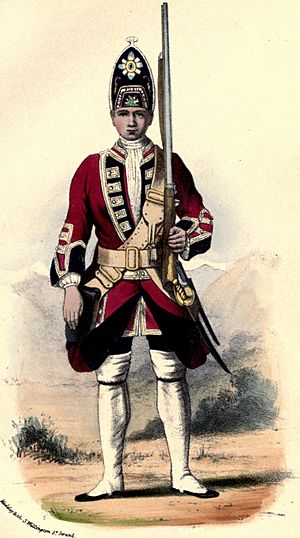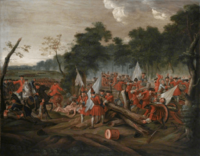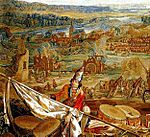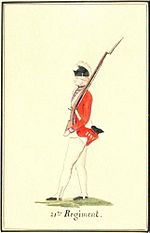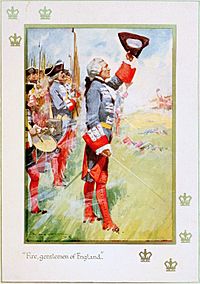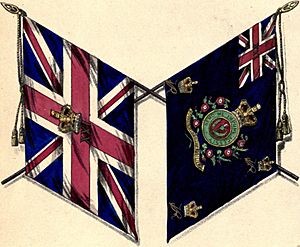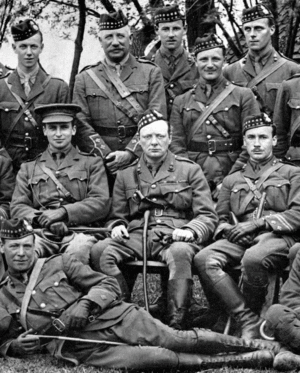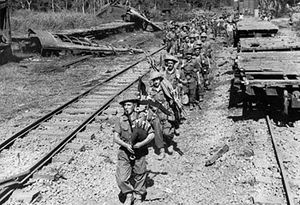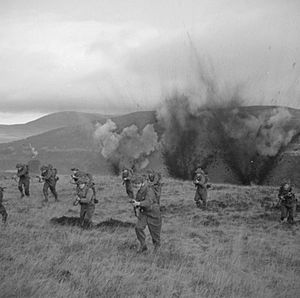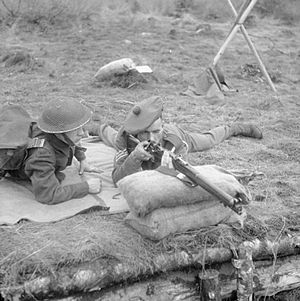Royal Scots Fusiliers facts for kids
Quick facts for kids Royal Scots Fusiliers |
|
|---|---|
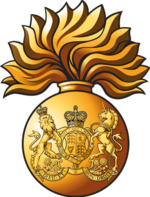
Regimental cap badge
|
|
| Active | 1678–1959 |
| Country | |
| Branch | |
| Type | Infantry |
| Role | Line infantry |
| Part of | Lowland Brigade |
| Garrison/HQ | Churchill Barracks, Ayr |
| Nickname(s) | Duke of Marlborough's Own The Grey Breeks |
| Motto(s) | Nec Aspera Terrent (Hardships do not deter us) |
| March | Highland Laddie (Pipes) |
| Insignia | |
| Hackle | White |
| Tartan | Hunting Erskine |
The Royal Scots Fusiliers was a famous infantry regiment in the British Army. It started in 1678 and lasted until 1959. Then, it joined with the Highland Light Infantry (City of Glasgow Regiment) to create the Royal Highland Fusiliers (Princess Margaret's Own Glasgow and Ayrshire Regiment). Later, this new regiment also merged with other Scottish regiments to form the Royal Regiment of Scotland.
Contents
- A Look Back: History of the Royal Scots Fusiliers
- How Regiments Got Their Names
- Early Years: The Earl of Mar's Regiment (1678–1689)
- Fighting in Europe: Nine Years' War (1689–1702)
- The War of the Spanish Succession (1702-1713)
- The Royal North British Fusiliers (1713–1877)
- The Royal Scots Fusiliers (1877–1908)
- The Royal Scots Fusiliers in the First World War
- The Royal Scots Fusiliers in the Second World War
- Joining Forces: Amalgamations of 1959
- Battle Honours
- Victoria Cross Heroes
A Look Back: History of the Royal Scots Fusiliers
How Regiments Got Their Names
In the late 1600s, many people in England and Scotland worried about having a permanent army. They thought it could threaten people's freedom. Because of past wars, regiments were often seen as belonging to their Colonel. Their name would change if the Colonel changed, and they were often disbanded quickly.
This makes it tricky to trace the history of old regiments. Later, in the 1800s, rules changed. Regiments were given numbers instead of just a Colonel's name. This helped keep track of them better.
Early Years: The Earl of Mar's Regiment (1678–1689)
The regiment began in Scotland in September 1678. It was formed by the Earl of Mar. Its first job was to help stop rebellions by a group called the Covenanters. They helped at the Battle of Bothwell Bridge in 1679 and Argyll's Rising in 1685.
In 1686, Thomas Buchan became the new Colonel. When William III arrived in England in 1688, many soldiers changed sides. Buchan went into exile. In 1689, Francis Fergus O'Farrell became the Colonel, and the regiment was called O'Farrell's Regiment.
Fighting in Europe: Nine Years' War (1689–1702)
The regiment fought in Flanders during the Nine Years' War. They were in major battles like Walcourt, Steinkirk, and Landen. In 1695, O'Farrell surrendered Deinze to the French. The regiment became prisoners.
O'Farrell and other officers were removed from their positions. They were later allowed back into the army. Robert Mackay became the new Colonel, followed by Archibald Row. After the war ended in 1697, the regiment returned to Scotland.
The regiment became a "Fusilier" unit around 1691. A "fusil" was a type of light musket. Fusilier units often guarded artillery. They might also have used grenades, as they were later allowed to use the march "the British Grenadiers".
The War of the Spanish Succession (1702-1713)
The regiment went back to Flanders in 1702 for the War of the Spanish Succession. They were part of the army led by the Duke of Marlborough. In 1704, they fought at the Battle of Blenheim. Colonel Row was badly wounded leading his men.
The regiment had many casualties. Viscount Mordaunt became the new Colonel. He lost an arm at Blenheim. After the Battle of Ramillies in 1706, Colonel Sampson de Lalo took command.
Under de Lalo, they fought at Oudenarde and helped capture Lille. Lille was one of Europe's strongest forts. De Lalo was killed at Malplaquet in 1709. This battle was a victory, but so many soldiers were hurt that it shocked Europe. The war ended in 1713 with the Treaty of Utrecht.
The Royal North British Fusiliers (1713–1877)
Around 1713, the regiment was given the title "Royal". They returned to England in 1714. In 1715, they fought against the Jacobite Rebellion at Sheriffmuir. They defeated the forces led by the son of their founder, the Earl of Mar.
Britain was peaceful for a while, and the regiment was on guard duty. Then, the War of the Austrian Succession began in 1742. They fought at Dettingen in 1743 and Fontenoy in 1745. Fontenoy was a British defeat, famous for the polite exchange where each side invited the other to fire first.
During the 1745 Rebellion, they helped defeat the Jacobite army at Culloden in 1746. In 1751, regiments were officially numbered by how old they were. This regiment became the 21st Regiment. They spent the next 20 years on guard duty in places like Gibraltar, Scotland, and Quebec.
The regiment fought in the American Revolutionary War at the Siege of Fort Ticonderoga in 1777. They were also in the Napoleonic Wars at the Siege of Bergen op Zoom in 1814. During the War of 1812, they fought at the Battle of New Orleans in 1815. Later, they served in the Crimean War at the Battle of Inkerman in 1854.
The Royal Scots Fusiliers (1877–1908)
In 1877, the regiment finally got "Scots" back in its name. In 1881, new army changes meant the regiment became The Royal Scots Fusiliers. It became the main regiment for several areas in South-West Scotland. This meant they were a Lowland Regiment and started wearing a type of trousers called trews. They fought in the Second Boer War at the Battle of the Tugela Heights in 1900.
In 1908, the army was reorganized. The regiment now had one Reserve battalion and two Territorial battalions.
The Royal Scots Fusiliers in the First World War
The 1st Battalion arrived in France in August 1914. They fought on the Western Front. They were in battles like the Battle of Mons (1914), the First Battle of Ypres (1914), and the Battle of the Somme (1916). They also fought at the Battle of Arras (1917).
The 2nd Battalion also arrived in France in October 1914. They fought on the Western Front too. Their battles included the First Battle of Ypres, the Battle of Neuve Chapelle (1915), and the Battle of Loos (1915). They also fought at the Somme and Arras.
Other battalions, like the 1/4th and 1/5th, fought in Gallipoli in 1915. After leaving Gallipoli, they moved to France. The 6th (Service) Battalion arrived in France in May 1915. Winston Churchill, who later became Prime Minister, commanded this battalion for a time in 1916. The 8th (Service) Battalion went to Salonika.
The Royal Scots Fusiliers in the Second World War
The 1st Battalion spent the entire war as part of the 29th Independent Infantry Brigade Group. They fought in the Battle of Madagascar in 1942. This was special because the 2nd Battalion also fought there. Both regular battalions were in the same action.
They then moved to India to fight in the South-East Asian Theatre. In 1944, the 29th Brigade joined the 36th Infantry Division. This division fought against the Japanese in Burma.
The 2nd Battalion was in Edinburgh when the war started. In 1939, they went to France as part of the British Expeditionary Force (BEF). They were involved in the Battle of Dunkirk and had to be evacuated back to England.
After two years in the UK, they fought in Madagascar. The battalion then saw service fighting in Sicily. In 1944, the division fought in the Battle of Anzio in Italy. This was very fierce fighting. After Anzio, they went to Palestine to rest. They returned to Italy briefly in 1945. Then, they moved to Belgium to join the Allied invasion of Germany.
The 4/5th and 6th battalions also served in Europe in 1944-1945. The 6th Battalion was in France in 1940. It was part of the BEF. The 4/5th Battalion was a combination of the 4th and 5th battalions. It was part of the 52nd (Lowland) Infantry Division. The 6th Battalion later fought in the Battle of Normandy.
The 50th (Holding) Battalion was formed in 1940. It was later renamed the 11th Battalion. It served with the 222nd Infantry Brigade and then the 147th Infantry Brigade. It stayed with the 49th (West Riding) Infantry Division for the rest of the war.
Joining Forces: Amalgamations of 1959
In 1959, the Royal Scots Fusiliers joined with the Highland Light Infantry (City of Glasgow Regiment). They formed a new regiment called the Royal Highland Fusiliers, (Princess Margaret's Own Glasgow and Ayrshire Regiment). The first battalions of both regiments combined to create the 1st Battalion of the new regiment.
Battle Honours
Battle honours are special awards given to regiments for their bravery in battles. These are the honours the Royal Scots Fusiliers earned. The ones in bold from the World Wars were chosen to be displayed on the King's Colour (the regiment's flag).
- Blenheim, Ramillies, Oudenarde, Malplaquet, Dettingen, Bellisle, Martinique 1794, Bladensburg, Alma, Inkerman, Sevastopol, South Africa 1879, Burma 1885–87, Tirah, Relief of Ladysmith, South Africa 1899–1902
- The Great War (18 battalions): Mons, Le Cateau, Retreat from Mons, Marne 1914, Aisne 1914, La Bassée 1914, Ypres 1914 '17 '18, Langemarck 1914, Gheluvelt, Nonne Bosschen, Neuve Chapelle, Aubers, Festubert 1915, Loos, Somme 1916 '18, Albert 1916 '18, Bazentin, Delville Wood, Pozières, Flers-Courcelette, Le Transloy, Ancre Heights, Ancre 1916, Arras 1917 '18, Scarpe 1917 '18, Arleux, Messines 1917, Pilckem, Menin Road, Polygon Wood, St Quentin, Bapaume 1918, Rosières, Lys, Estaires, Hazebrouck, Bailleul, Béthune, Scherpenberg, Drocourt-Quéant, Hindenberg Line, Canal du Nord, Courtrai, Selle, France and Flanders 1914–18, Doiran 1917 '18, Macedonia 1916–18, Helles, Gallipoli 1915–16, Rumani, Egypt 1916–17, Gaza, El Mughar, Nebi Samwil, Jerusalem, Jaffa, Tel Asur, Palestine 1917–18
- The Second World War: Defence of Arras, Ypres-Comines Canal, Somme 1940, Withdrawal to Seine, Odon, Fontenay le Pesnil, Cheux, Defence of Rauray, Mont Pincon, Estry, Falaise, Le Vie Crossing, La Touques Crossing, Aart, Nederrijn, Best, Le Havre, Antwerp-Turnhout Canal, Scheldt, South Beveland, Lower Maas, Meijel, Venlo Pocket, Roer, Rhineland, Reichswald, Cleve, Goch, Rhine, Dreirwalde, Uelzen, Bremen, Artlenberg, North-West Europe 1940 '44–45, Landing in Sicily, Sicily 1943, Sangro, Garigliano Crossing, Minturno, Anzio, Advance to Tiber, Italy 1943–44, Madagascar, Middle East 1942, North Arakan, Razabil, Pinwe, Shweli, Mandalay, Burma 1944–45
- 4th Battalion: South Africa 1900–02
- 5th Battalion: South Africa 1900–01
Victoria Cross Heroes
The Victoria Cross is the highest award for bravery in the British armed forces. These brave soldiers from the Royal Scots Fusiliers earned this medal:
- Second Lieutenant Stanley Henry Parry Boughey, First World War (1 December 1917)
- Sergeant Thomas Caldwell, First World War (31 October 1918)
- Second Lieutenant John Manson Craig, First World War (5 June 1917)
- Fusilier Dennis Donnini, Second World War (18 January 1945)
- Private David Ross Lauder, First World War (13 August 1915)
- Private George Ravenhill, Second Boer War (15 December 1899)


